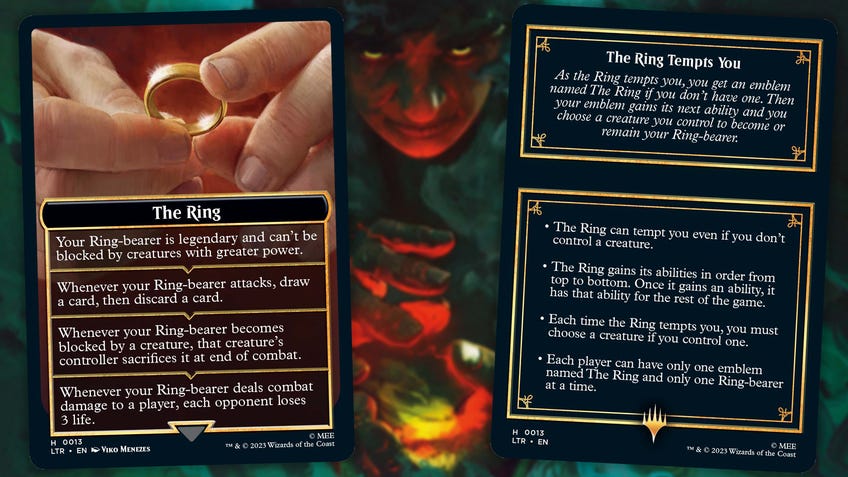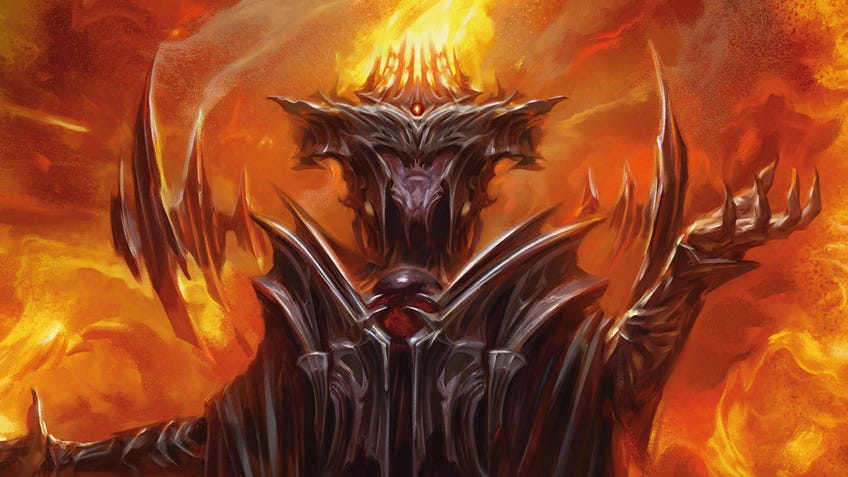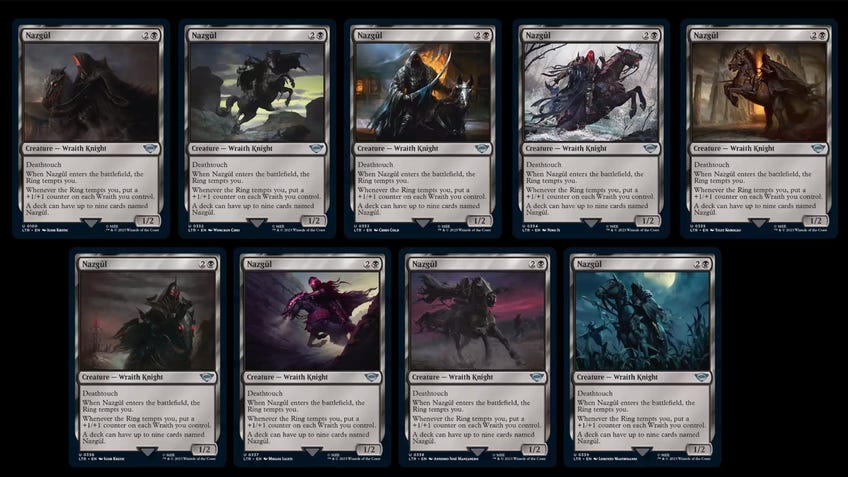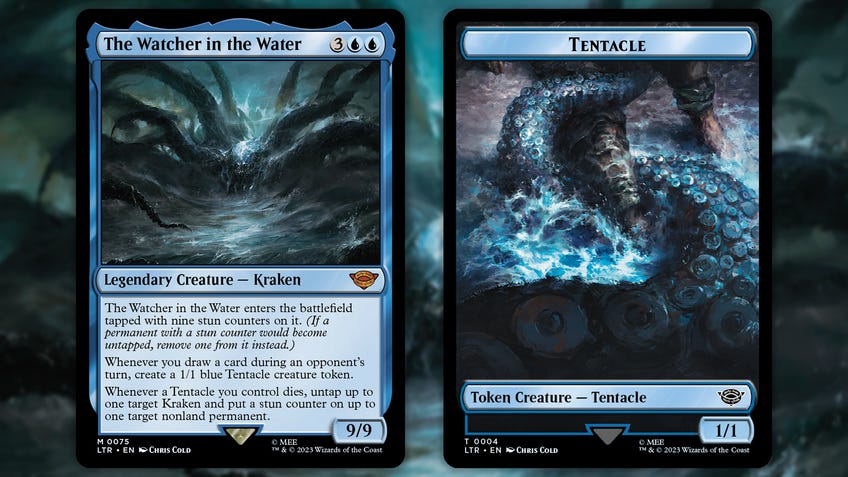Tales of Middle-earth is an excellent reimagining of Lord of the Rings that raises the bar for Magic: The Gathering’s crossovers
One set to guide them all.
Tales of Middle-Earth is our next big Magic: The Gathering Universes Beyond release. Rather than bringing in another Wizards of the Coast franchise like Dungeons & Dragons, or just being a few Commander decks like the Warhammer 40,000 crossover, MTG’s Lord of the Rings set is just that: a full set.
What that means is this is a fully draftable set, albeit one that’s not Standard-legal, but that can be played in basically every other MTG format - which is good news for just about everyone who wants to enjoy playing with cards from the progenitor of many modern-day fantasy settings.
Aside from the innate hold that The Lord of the Rings has on us, whether that’s as fans of the books or the incredible films, Tales of Middle-earth is the first MTG set to try and prove that Wizards can bring just about any outside property into the card game, and do it well.
Tales of Middle-earth achieves that, as this set is one that’s not only good to draft, but also one that adds in new mechanics that fit well into various formats, and a release that will undoubtedly be a huge hit in Commander, too.

As with any set, the mechanics play a huge part in the feel of Tales of Middle-Earth. While there is only one new mechanic, it’s kind of a doozy. The new mechanic is just called The Ring, although it’s usually written as “the Ring tempts you”. This is a reference to the alluring and seductive nature of Sauron’s One Ring, which is responsible for turning Smeagol into Gollum and Frodo into an emo kid.
The One Ring is the embodiment of the idea that power corrupts people. In Magic: The Gathering, it’s represented by slowly changing a creature into something far more powerful. To do this in-game, it has a few different effects. The short of it, though, is that every time the Ring tempts you, your Ring-bearer creature, of which you can only have one at a time, gains a new ability. It first becomes a legendary that can’t be blocked by creatures with greater power, then allows you to draw a card and discard a card when it attacks, then it can make opponents sacrifice creatures if it gets blocked, and, finally, it causes all of your opponents to lose three life whenever it hits another player.

You can change which creature is your Ring-bearer whenever the Ring tempts you, which allows for a lot of interesting plays. Plus, it’s actually the Ring that gains these abilities when it tempts you, not the creature - which means it scales well as the battle continues on. It’s not just the Ring that can tempt you either, as there are a few cards that have special effects when the Ring tempts you and some that benefit from being your Ring-bearer.
The 'Ring tempts you' mechanic is an excellent way of bringing the influence of that one small artefact into MTG.
For example, Ringwraiths, a six-mana Black 5/5, not only gives an opposing creature -3/-3 until end of turn when it enters the battlefield, but also returns to your hand from the graveyard whenever the Ring tempts you. You’ve also got cards like Aragorn, Company Leader, which reads: “Whenever the Ring tempts you, if you chose a creature other than Aragorn, Company Leader as your Ring-bearer, put your choice of a counter from among first strike, vigilance, deathtouch, and lifelink on Aragorn. Whenever you put one or more counters on Aragorn, put one of each of those kinds of counters on up to one other target creature.”
Despite this only being one mechanic, it has a huge number of ways it can affect the game, which feels very true to how much of an impact The One Ring has on the story of The Lord of the Rings. It’s an excellent way of bringing the influence of that one small artefact into MTG, without it just being a single card. (Although the card itself is also very good.)

The only other mechanic that’s sort of new is a return of amass. Amass was a mechanic first seen back in War of the Spark. In Tales of Middle-earth, it allows you to first create an Orc Army creature token, and then put counters on it. It interacts with the old amass; if you do both, you end up with a Zombie Orc Army, which is fun. Other than that, we’ve got food tokens back, historic cards - which are legendary cards, artifacts or Sagas - are important again, and a few other returning keywords too.
The interactions between all of its mechanics help Tales of Middle-earth feel as though it was built from the ground up just for The Lord of the Rings.
The interactions between all of these mechanics help Tales of Middle-earth feel as though it was built from the ground up just for The Lord of the Rings, even though most of the mechanics have been in Magic: The Gathering for a while now. It’s a testament to how well-designed it all is and, while the set plays incredibly well, it’s also evident in how different characters are represented in card form.
Take The Watcher in the Water, which you might remember as being the big old kraken monster in the lake outside the glowy door to Moria that challenges Gandalf to speak friend to enter it. This creature in the books, and the films, is one that lurks and bides its time. It doesn’t go for an all-out attack, but slowly reveals itself when it’s in a good position to do so.
In this set, The Watcher in the Water is a five-mana Blue 9/9 which enters the battlefield tapped and with nine stun counters on it. Stun counters stop a permanent untapping, and instead have one of those counters removed when it would normally be untapped. The card then reads: “Whenever you draw a card during an opponent’s turn, create a 1/1 blue Tentacle creature token. Whenever a Tentacle you control dies, untap up to one target Kraken and put a stun counter on up to one target nonland permanent.”
Basically, it slowly puts out tentacles to feel how things are going on. You can not only remove stun counters from it faster by choosing to untap it, but also put a stun counter on something else. It’s an exquisite bit of design that perfectly represents this legendary creature, and it’s the same across the board with every famous denizen of Middle-earth.

Also, while the absurd number of alternate art on cards is usually a little over-the-top, a lot of the special versions in this set actually line up to make a complete image. There’s one that uses a total of 18 cards to show off the massive clash between armies at Pelennor Fields with Mount Doom in the background. The lower section of the scene is made up of Knights of Dol Amroth, Orcish Bowmasters, Aragorn, the Uniter, Legolas, Master Archer, Gimli, Mournful Avenger, and Merry, Esquire of Rohan. The fall of Saruman at Orthanc is depicted across nine different cards, and Bilbo’s birthday party is on six cards too. It’s the care that Wizards puts into these Universes Beyond sets that really helps make them worthy of attention, and Tales of Middle-earth has raised the bar once again.
We can’t help but look forward to every crossover at this point, because they seem to be getting better and better as time goes on, and that can only be a good thing. Long live the Fortniteification of Magic: The Gathering, as long as the quality stays this high.










